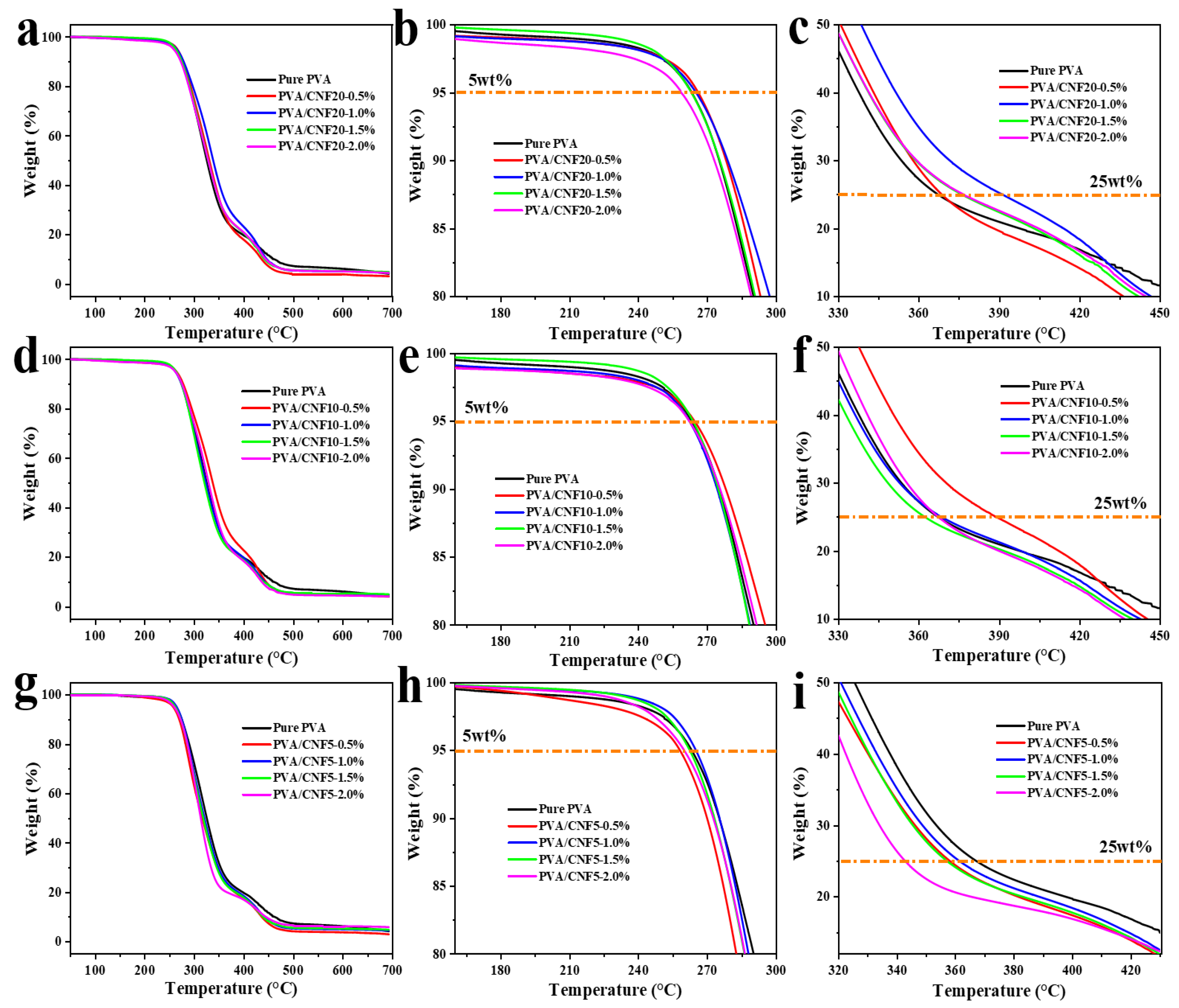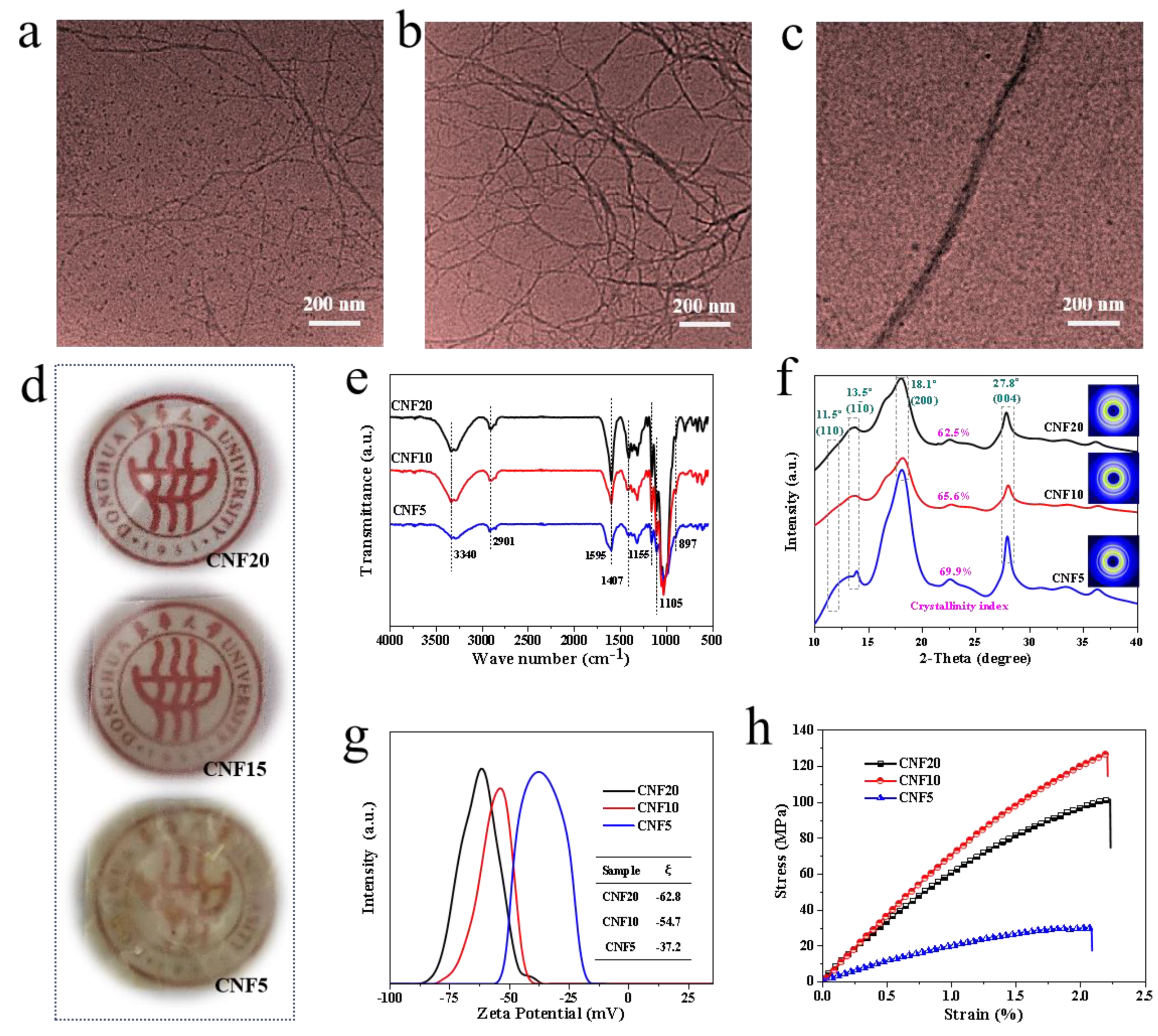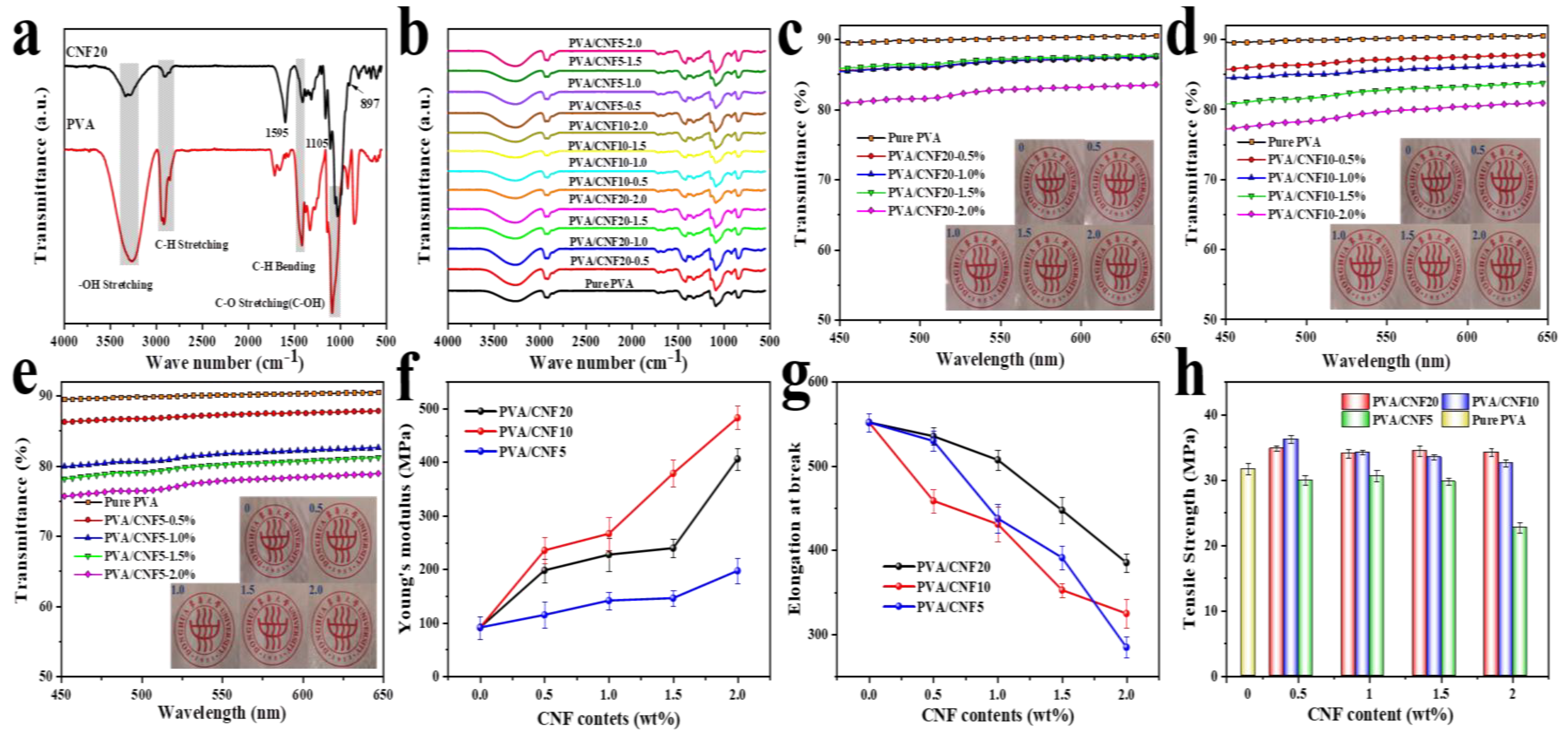Effect of Length of Cellulose Nanofibers on Mechanical Reinforcement of Polyvinyl Alcohol
Abstract
:1. Introduction
2. Materials and Methods
2.1. Materials
2.2. Preparation of CNF of Different Sizes
2.3. Preparation of PVA/CNF Films
2.4. Transmission Electron Microscopy (TEM)
2.5. Fourier Transform Infrared Spectroscopy (FTIR)
2.6. Particle Size and Zeta Potential Measurement
2.7. Mechanical Properties
2.8. Thermal Properties
2.9. UV-Vis Spectra
2.10. The Degree of Carboxylation of TEMPO-Oxidized CNFs
3. Results and Discussion
3.1. Characterization of CNF with Different Lengths
3.2. Determination of the Content of Carboxyl Groups and Carboxylate in CNFs
3.3. Thermal Properties of CNFs with Different Lengths
3.4. The Effects of Morphology and Dimension of CNF on PVA/CNF Composites
3.4.1. Chemical Strcture
3.4.2. Optical Transparency
3.4.3. Mechanical Properties
3.4.4. Thermal Properties


3.4.5. The Comparison of this Work with Other Researches
4. Conclusions
Supplementary Materials
Author Contributions
Funding
Data Availability Statement
Conflicts of Interest
References
- Yun, Y.-H.; Eteshola, E.; Bhattacharya, A.; Dong, Z.; Shim, J.-S.; Conforti, L.; Kim, D.; Schulz, M.J.; Ahn, C.H.; Watts, N. Tiny medicine: Nanomaterial-based biosensors. Sensors 2009, 9, 9275–9299. [Google Scholar] [CrossRef] [Green Version]
- Lalwani, G.; Patel, S.C.; Sitharaman, B. Two-and three-dimensional all-carbon nanomaterial assemblies for tissue engineering and regenerative medicine. Ann. Biomed. Eng. 2016, 44, 2020–2035. [Google Scholar] [CrossRef]
- Wu, Z.; Wang, Y.; Liu, X.; Lv, C.; Li, Y.; Wei, D.; Liu, Z. Carbon-nanomaterial-based flexible batteries for wearable electronics. Adv. Mater. 2019, 31, 1800716. [Google Scholar] [CrossRef]
- Kumar, L.Y. Role and adverse effects of nanomaterials in food technology. J. Toxicol. Health 2015, 2, 1–11. [Google Scholar] [CrossRef] [Green Version]
- Joo, J.I.; Choi, M.; Jang, S.H.; Choi, S.; Park, S.M.; Shin, D.; Cho, K.H. Realizing cancer precision medicine by integrating systems biology and nanomaterial engineering. Adv. Mater. 2020, 32, 1906783. [Google Scholar] [CrossRef] [PubMed]
- Shi, H.; Liu, W.; Xie, Y.; Yang, M.; Liu, C.; Zhang, F.; Wang, S.; Liang, L.; Pi, K. Synthesis of carboxymethyl chitosan-functionalized graphene nanomaterial for anticorrosive reinforcement of waterborne epoxy coating. Carbohydr. Polym. 2021, 252, 117249. [Google Scholar] [CrossRef]
- Ghasemi, S.; Tajvidi, M.; Bousfield, D.W.; Gardner, D.J. Reinforcement of natural fiber yarns by cellulose nanomaterials: A multi-scale study. Ind. Crops Prod. 2018, 111, 471–481. [Google Scholar] [CrossRef]
- Bilkar, D.; Keshavamurthy, R.; Tambrallimath, V. Influence of carbon nanofiber reinforcement on mechanical properties of polymer composites developed by FDM. Mater. Today Proc. 2021, 46, 4559–4562. [Google Scholar] [CrossRef]
- Yano, H.; Omura, H.; Honma, Y.; Okumura, H.; Sano, H.; Nakatsubo, F. Designing cellulose nanofiber surface for high density polyethylene reinforcement. Cellulose 2018, 25, 3351–3362. [Google Scholar] [CrossRef] [Green Version]
- Jiang, S.; Chen, Y.; Duan, G.; Mei, C.; Greiner, A.; Agarwal, S. Electrospun nanofiber reinforced composites: A review. Polym. Chem. 2018, 9, 2685–2720. [Google Scholar] [CrossRef]
- Platnieks, O.; Gaidukovs, S.; Barkane, A.; Sereda, A.; Gaidukova, G.; Grase, L.; Thakur, V.K.; Filipova, I.; Fridrihsone, V.; Skute, M.; et al. Bio-Based Poly(butylene succinate)/Microcrystalline Cellulose/Nanofibrillated Cellulose-Based Sustainable Polymer Composites: Thermo-Mechanical and Biodegradation Studies. Polymers 2020, 12, 1472. [Google Scholar] [CrossRef]
- Othman, S.H.; Wane, B.M.; Nordin, N.; Noor Hasnan, N.Z.; Talib, R.A.; Karyadi, J.N.W. Physical, Mechanical, and Water Vapor Barrier Properties of Starch/Cellulose Nanofiber/Thymol Bionanocomposite Films. Polymers 2021, 13, 4060. [Google Scholar] [CrossRef] [PubMed]
- Katiyar, N.K.; Biswas, K.; Tiwary, C. Cryomilling as environmentally friendly synthesis route to prepare nanomaterials. Int. Mater. Rev. 2021, 66, 493–532. [Google Scholar] [CrossRef]
- Kawamoto, M.; He, P.; Ito, Y. Green processing of carbon nanomaterials. Adv. Mater. 2017, 29, 1602423. [Google Scholar] [CrossRef] [PubMed]
- Rai, G.K.; Singh, V. Study of fabrication and analysis of nanocellulose reinforced polymer matrix composites. Mater. Today Proc. 2021, 38, 85–88. [Google Scholar]
- Basiuk, V.A.; Basiuk, E.V. Green Processes for Nanotechnology; Springer: Berlin/Heidelberg, Germany, 2015; p. 446. [Google Scholar]
- Teo, H.L.; Wahab, R.A. Towards an eco-friendly deconstruction of agro-industrial biomass and preparation of renewable cellulose nanomaterials: A review. Int. J. Biol. Macromol. 2020, 161, 1414–1430. [Google Scholar] [CrossRef]
- Moon, R.J.; Martini, A.; Nairn, J.; Simonsen, J.; Youngblood, J. Cellulose nanomaterials review: Structure, properties and nanocomposites. Chem. Soc. Rev. 2011, 40, 3941–3994. [Google Scholar] [CrossRef]
- Nechyporchuk, O.; Belgacem, M.N.; Bras, J. Production of cellulose nanofibrils: A review of recent advances. Ind. Crops Prod. 2016, 93, 2–25. [Google Scholar] [CrossRef]
- Salimi, S.; Sotudeh-Gharebagh, R.; Zarghami, R.; Chan, S.Y.; Yuen, K.H. Production of Nanocellulose and Its Applications in Drug Delivery: A Critical Review. ACS Sustain. Chem. Eng. 2019, 7, 15800–15827. [Google Scholar] [CrossRef]
- Lee, H.; You, J.; Jin, H.-J.; Kwak, H.W. Chemical and physical reinforcement behavior of dialdehyde nanocellulose in PVA composite film: A comparison of nanofiber and nanocrystal. Carbohydr. Polym. 2020, 232, 115771. [Google Scholar] [CrossRef] [PubMed]
- Wang, Z.; Qiao, X.; Sun, K. Rice straw cellulose nanofibrils reinforced poly (vinyl alcohol) composite films. Carbohydr. Polym. 2018, 197, 442–450. [Google Scholar] [CrossRef] [PubMed]
- Naidu, D.S.; John, M.J. Cellulose nanofibrils reinforced xylan-alginate composites: Mechanical, thermal and barrier properties. Int. J. Biol. Macromol. 2021, 179, 448–456. [Google Scholar] [CrossRef]
- Espinosa, E.; Bascón-Villegas, I.; Rosal, A.; Pérez-Rodríguez, F.; Chinga-Carrasco, G.; Rodríguez, A. PVA/(ligno) nanocellulose biocomposite films. Effect of residual lignin content on structural, mechanical, barrier and antioxidant properties. Int. J. Biol. Macromol. 2019, 141, 197–206. [Google Scholar] [CrossRef]
- Miao, X.; Tian, F.; Lin, J.; Li, H.; Li, X.; Bian, F.; Zhang, X. Tuning the mechanical properties of cellulose nanofibrils reinforced polyvinyl alcohol composites via altering the cellulose polymorphs. RSC Adv. 2016, 6, 83356–83365. [Google Scholar] [CrossRef]
- Hamou, K.B.; Kaddami, H.; Dufresne, A.; Boufi, S.; Magnin, A.; Erchiqui, F. Impact of TEMPO-oxidization strength on the properties of cellulose nanofibril reinforced polyvinyl acetate nanocomposites. Carbohydr. Polym. 2018, 181, 1061–1070. [Google Scholar] [CrossRef]
- Jabbar, A.; Militký, J.; Wiener, J.; Kale, B.M.; Ali, U.; Rwawiire, S. Nanocellulose coated woven jute/green epoxy composites: Characterization of mechanical and dynamic mechanical behavior. Compos. Struct. 2017, 161, 340–349. [Google Scholar] [CrossRef]
- Chen, R.-D.; Huang, C.-F.; Hsu, S.-h. Composites of waterborne polyurethane and cellulose nanofibers for 3D printing and bioapplications. Carbohydr. Polym. 2019, 212, 75–88. [Google Scholar] [CrossRef] [PubMed]
- Rana, A.K.; Frollini, E.; Thakur, V.K. Cellulose nanocrystals: Pretreatments, preparation strategies, and surface functionalization. Int. J. Biol. Macromol. 2021, 182, 1554–1581. [Google Scholar] [CrossRef]
- Beluns, S.; Gaidukovs, S.; Platnieks, O.; Gaidukova, G.; Mierina, I.; Grase, L.; Starkova, O.; Brazdausks, P.; Thakur, V.K. From wood and hemp biomass wastes to sustainable nanocellulose foams. Ind. Crops Prod. 2021, 170, 113780. [Google Scholar] [CrossRef]
- Ni, Y.; Li, J.; Fan, L. Production of nanocellulose with different length from ginkgo seed shells and applications for oil in water Pickering emulsions. Int. J. Biol. Macromol. 2020, 149, 617–626. [Google Scholar] [CrossRef]
- Fukuzumi, H.; Saito, T.; Isogai, A. Influence of TEMPO-oxidized cellulose nanofibril length on film properties. Carbohydr. Polym. 2013, 93, 172–177. [Google Scholar] [CrossRef] [PubMed]
- Li, T.; Li, M.; Zhong, Q.; Wu, T. Effect of Fibril Length on the Ice Recrystallization Inhibition Activity of Nanocelluloses. Carbohydr. Polym. 2020, 240, 116275. [Google Scholar] [CrossRef] [PubMed]
- Mehrali, M.; Shirazi, F.S.; Mehrali, M.; Metselaar, H.S.C.; Kadri, N.A.B.; Osman, N.A.A. Dental implants from functionally graded materials. J. Biomed. Mater. Res. Part A Off. J. Soc. Biomater. Jpn. Soc. Biomater. Aust. Soc. Biomater. Korean Soc. Biomater. 2013, 101, 3046–3057. [Google Scholar] [CrossRef]
- Lee, S.-Y.; Mohan, D.J.; Kang, I.-A.; Doh, G.-H.; Lee, S.; Han, S.O. Nanocellulose reinforced PVA composite films: Effects of acid treatment and filler loading. Fibers Polym. 2009, 10, 77–82. [Google Scholar] [CrossRef]
- Gan, P.; Sam, S.; Abdullah, M.F.b.; Omar, M.F. Thermal properties of nanocellulose-reinforced composites: A review. J. Appl. Polym. Sci. 2020, 137, 48544. [Google Scholar] [CrossRef] [Green Version]
- Nazrin, A.; Sapuan, S.; Zuhri, M. Mechanical, physical and thermal properties of sugar palm nanocellulose reinforced thermoplastic starch (TPS)/poly (lactic acid)(PLA) blend bionanocomposites. Polymers 2020, 12, 2216. [Google Scholar] [CrossRef] [PubMed]
- El Miri, N.; Abdelouahdi, K.; Zahouily, M.; Fihri, A.; Barakat, A.; Solhy, A.; El Achaby, M. Bio-nanocomposite films based on cellulose nanocrystals filled polyvinyl alcohol/chitosan polymer blend. J. Appl. Polym. Sci. 2015, 132, 42004. [Google Scholar] [CrossRef]
- Awad, S. Enhancing the Thermal and Mechanical Characteristics of Polyvinyl Alcohol (PVA)-Hemp Protein Particles (HPP) Composites. Int. Polym. Processing 2021, 36, 137–143. [Google Scholar] [CrossRef]
- Awad, S.A.; Khalaf, E.M. Investigation of photodegradation preventing of polyvinyl alcohol/nanoclay composites. J. Polym. Environ. 2019, 27, 1908–1917. [Google Scholar] [CrossRef]
- Begum, M.H.A.; Hossain, M.M.; Gafur, M.A.; KABIR, A.; Tanvir, N.I.; Molla, M.R. Preparation and characterization of polyvinyl alcohol–starch composites reinforced with pulp. SN Appl. Sci. 2019, 1, 1–9. [Google Scholar] [CrossRef] [Green Version]
- Spagnol, C.; Fragal, E.H.; Witt, M.A.; Follmann, H.D.; Silva, R.; Rubira, A.F. Mechanically improved polyvinyl alcohol-composite films using modified cellulose nanowhiskers as nano-reinforcement. Carbohydr. Polym. 2018, 191, 25–34. [Google Scholar] [CrossRef] [PubMed]
- Sameer, A. Investigation of Chemical Modification and Enzymatic Degradation of Poly (vinyl alcohol)/Hemoprotein Particle Composites. J. Turk. Chem. Soc. Sect. A Chem. 2021, 8, 651–658. [Google Scholar]
- Zheng, Q.; Cai, Z.; Gong, S. Green synthesis of polyvinyl alcohol (PVA)–cellulose nanofibril (CNF) hybrid aerogels and their use as superabsorbents. J. Mater. Chem A 2014, 2, 3110. [Google Scholar] [CrossRef]
- Isogai, A.; Saito, T.; Fukuzumi, H. TEMPO-oxidized cellulose nanofibers. Nanoscale 2011, 3, 71–85. [Google Scholar] [CrossRef]
- Saito, T.; Isogai, A. TEMPO-mediated oxidation of native cellulose. The effect of oxidation conditions on chemical and crystal structures of the water-insoluble fractions. Biomacromolecules 2004, 5, 1983–1989. [Google Scholar] [CrossRef] [PubMed]
- Song, L.; Miao, X.; Li, X.; Bian, F.; Lin, J.; Huang, Y. A tunable alkaline/oxidative process for cellulose nanofibrils exhibiting different morphological, crystalline properties. Carbohydr. Polym. 2021, 259, 117755. [Google Scholar] [CrossRef] [PubMed]
- Zhbankov, R. Infrared Spectra of Cellulose and its Derivatives. In Consultants Bureau; Plenum Publishing Co.: New York, NY, USA, 1966. [Google Scholar]
- Hermans, P.H. Physics and Chemistry of Cellulose Fibres; Elsevier: Amsterdam, The Netherlands, 1949; Volume 26, p. 683. [Google Scholar]
- Chitbanyong, K.; Pitiphatharaworachot, S.; Pisutpiched, S.; Khantayanuwong, S.; Puangsin, B. Characterization of bamboo nanocellulose prepared by TEMPO-mediated oxidation. BioResources 2018, 13, 4440–4454. [Google Scholar] [CrossRef] [Green Version]
- Tanpichai, S.; Wimolmala, E. Facile Single-step Preparation of Cellulose Nanofibers by TEMPO-mediated Oxidation and Their Nanocomposites. J. Nat. Fibers 2021, 1–17. [Google Scholar] [CrossRef]
- Zhbankov, R.; Firsov, S.; Buslov, D.; Nikonenko, N.; Marchewka, M.; Ratajczak, H. Structural physico-chemistry of cellulose macromolecules. Vibrational spectra and structure of cellulose. J. Mol. Struct. 2002, 614, 117–125. [Google Scholar] [CrossRef]
- Nicely, W.B. Infrared spectra of carbohydrates. In Advances in Carbohydrate Chemistry; Academic Press: Cambridge, MA, USA, 1957; Volume 12, pp. 13–33. [Google Scholar]
- Puangsin, B.; Soeta, H.; Saito, T.; Isogai, A. Characterization of cellulose nanofibrils prepared by direct TEMPO-mediated oxidation of hemp bast. Cellulose 2017, 24, 3767–3775. [Google Scholar] [CrossRef]
- Pelissari, F.M.; Sobral, P.J.d.A.; Menegalli, F.C. Isolation and characterization of cellulose nanofibers from banana peels. Cellulose 2013, 21, 417–432. [Google Scholar] [CrossRef]
- Kanai, N.; Honda, T.; Yoshihara, N.; Oyama, T.; Naito, A.; Ueda, K.; Kawamura, I. Structural characterization of cellulose nanofibers isolated from spent coffee grounds and their composite films with poly (vinyl alcohol): A new non-wood source. Cellulose 2020, 27, 5017–5028. [Google Scholar] [CrossRef]
- Sánchez-Gutiérrez, M.; Espinosa, E.; Bascón-Villegas, I.; Pérez-Rodríguez, F.; Carrasco, E.; Rodríguez, A. Production of Cellulose Nanofibers from Olive Tree Harvest—A Residue with Wide Applications. Agronomy 2020, 10, 696. [Google Scholar] [CrossRef]
- Kohli, D.; Garg, S.; Jana, A. Physical, mechanical, optical and biodegradability properties of polyvinyl alcohol/cellulose nanofibrils/kaolinite clay-based hybrid composite films. Indian Chem. Eng. 2021, 63, 62–74. [Google Scholar] [CrossRef]
- Asad, M.; Saba, N.; Asiri, A.M.; Jawaid, M.; Indarti, E.; Wanrosli, W. Preparation and characterization of nanocomposite films from oil palm pulp nanocellulose/poly (Vinyl alcohol) by casting method. Carbohydr. Polym. 2018, 191, 103–111. [Google Scholar] [CrossRef]
- Liu, D.; Sun, X.; Tian, H.; Maiti, S.; Ma, Z. Effects of cellulose nanofibrils on the structure and properties on PVA nanocomposites. Cellulose 2013, 20, 2981–2989. [Google Scholar] [CrossRef]
- Waymack, B.E.; Belote, J.L.; Baliga, V.L.; Hajaligol, M.R. Effects of metal salts on char oxidation in pectins/uronic acids and other acid derivative carbohydrates. Fuel 2004, 83, 1505–1518. [Google Scholar] [CrossRef]
- Raemy, A.; Schweizer, T. Thermal behaviour of carbohydrates studied by heat flow calorimetry. J. Therm. Anal. Calorim. 1983, 28, 95–108. [Google Scholar] [CrossRef]
- Okita, Y.; Saito, T.; Isogai, A. Entire surface oxidation of various cellulose microfibrils by TEMPO-mediated oxidation. Biomacromolecules 2010, 11, 1696–1700. [Google Scholar] [CrossRef]
- Jakab, E.; Mészáros, E.; Borsa, J. Effect of slight chemical modification on the pyrolysis behavior of cellulose fibers. J. Anal. Appl. Pyrolysis 2010, 87, 117–123. [Google Scholar] [CrossRef]
- Tanpichai, S.; Sampson, W.W.; Eichhorn, S.J. Stress-transfer in microfibrillated cellulose reinforced poly (lactic acid) composites using Raman spectroscopy. Compos. Part A Appl. Sci. Manuf. 2012, 43, 1145–1152. [Google Scholar] [CrossRef]





| Samples | Tonset/°C | Tmax1/°C | Tmax2/°C | Char Yield/% |
|---|---|---|---|---|
| CNF20 | 206.93 | 256.08 | 313.85 | 25.90 |
| CNF10 | 220.73 | 257.29 | 321.44 | 25.89 |
| CNF5 | 225.21 | 259.36 | 327.99 | 28.06 |
| Film | CNF Content (%) | Tensile Strength (MPa) | Elongation at Break (%) | Young’s Modulus (MPa) |
|---|---|---|---|---|
| PVA | 0 | 31.65 ± 0.85 | 550.61 ± 11.06 | 91.00 ± 21.64 |
| PVA/CNF20 | 0.5 | 34.84 ± 0.44 | 535.26 ± 10.71 | 197.73 ± 22.03 |
| 1.0 | 34.02 ± 0.71 | 507.12 ± 11.65 | 227.41 ± 30.59 | |
| 1.5 | 34.46 ± 0.80 | 447.24 ± 15.49 | 239.29 ± 17.22 | |
| 2.0 | 34.22 ± 0.66 | 385.04 ± 10.73 | 405.80 ± 20.34 | |
| PVA/CNF10 | 0.5 | 36.21 ± 0.62 | 458.49 ± 13.85 | 234.98 ± 24.25 |
| 1.0 | 34.21 ± 0.33 | 430.71 ± 20.47 | 266.22 ± 30.66 | |
| 1.5 | 33.48 ± 0.43 | 352.42 ± 8.58 | 378.88 ± 25.25 | |
| 2.0 | 32.55 ± 0.56 | 324.52 ± 6.78 | 482.75 ± 21.95 | |
| PVA/CNF5 | 0.5 | 29.97 ± 0.72 | 529.64 ± 11.06 | 114.48 ± 24.21 |
| 1.0 | 30.64 ± 0.85 | 437.54 ± 11.75 | 141.27 ± 16.57 | |
| 1.5 | 29.75 ± 0.48 | 390.89 ± 17.21 | 145.77 ± 14.87 | |
| 2.0 | 22.71 ± 0.82 | 284.42 ± 12.48 | 196.83 ± 23.33 |
| Film | CNF Content (%) | T−5%/°C | T25%/°C |
|---|---|---|---|
| PVA | 0 | 263.07 | 367.21 |
| PVA/CNF20 | 0.5 | 265.97 | 368.63 |
| 1.0 | 264.95 | 391.12 | |
| 1.5 | 262.94 | 376.18 | |
| 2.0 | 258.38 | 376.81 | |
| PVA/CNF10 | 0.5 | 264.51 | 388.55 |
| 1.0 | 262.27 | 368.36 | |
| 1.5 | 263.84 | 361.96 | |
| 2.0 | 262.21 | 367.24 | |
| PVA/CNF5 | 0.5 | 258.25 | 358.17 |
| 1.0 | 265.17 | 361.43 | |
| 1.5 | 262.56 | 357.07 | |
| 2.0 | 260.15 | 342.87 |
| Samples | PVA | 20–0.5 | 20–1.0 | 20–1.5 | 20–2.0 | 10–0.5 | 10–1.0 | 10–1.5 | 10–2.0 | 5–0.5 | 5–1.0 | 5–1.5 | 5–2.0 |
|---|---|---|---|---|---|---|---|---|---|---|---|---|---|
| Tg/°C | 80 | 80 | 80 | 80 | 80 | 80 | 80 | 80 | 80 | 83 | 82 | 85 | 84 |
| ΔE’ at Tg /MPa | 1096 | 1225 | 1289 | 1681 | 1333 | 1156 | 1376 | 1173 | 1142 | 1263 | 1453 | 1030 | 1370 |
| Samples | CNF Morphology | σ/MPa | ε/% | Ε/MPa | Tr./% | Td/°C | References | ||||||
|---|---|---|---|---|---|---|---|---|---|---|---|---|---|
| D/nm | L/nm | After | Before | After | Before | After | Before | After | Before | After | Before | ||
| PVA/MFC | 365 | - | 48 1 | 41 | - | - | 1600 1 | 1200 | - | - | 2651 | 252 | [65] |
| EVA/CNF | 5–10 | - | 3.64 2 | 3.32 | 688 2 | 750 | 6.92 2 | 5.36 | 77 2 | 78 | - | 320–380 | [51] |
| PVA/CNF-Ⅰ | 10–15 | 1120 | 44.30 3 | 39.08 | 89.2 3 | 320.5 | 1473.86 3 | 96.09 | 53 3 | 90 | 294.9 4 | 272.5 | [25] |
| PVA/CNF-Ⅱ | 250 | 44.59 3 | 39.08 | 313 3 | 320.5 | 276.2 3 | 96.09 | 86 3 | 287.4 4 | 272.5 | |||
| PVA/CNF20 | 5–10 | 200–1000 | 34.22 5 | 31.65 | 385.04 5 | 550.61 | 405.80 5 | 91 | 83.51 5 | 90.84 | 258.38 5 | 263.07 | This work |
| PVA/CNF10 | 10–15 | 1000–3000 | 32.55 5 | 324.52 5 | 482.75 5 | 80.51 5 | 262.21 5 | ||||||
| PVA/CNF5 | 20–50 | >3000 | 22.71 5 | 284.42 5 | 196.83 5 | 77.55 5 | 260.15 5 | ||||||
Publisher’s Note: MDPI stays neutral with regard to jurisdictional claims in published maps and institutional affiliations. |
© 2021 by the authors. Licensee MDPI, Basel, Switzerland. This article is an open access article distributed under the terms and conditions of the Creative Commons Attribution (CC BY) license (https://creativecommons.org/licenses/by/4.0/).
Share and Cite
Wang, M.; Miao, X.; Li, H.; Chen, C. Effect of Length of Cellulose Nanofibers on Mechanical Reinforcement of Polyvinyl Alcohol. Polymers 2022, 14, 128. https://doi.org/10.3390/polym14010128
Wang M, Miao X, Li H, Chen C. Effect of Length of Cellulose Nanofibers on Mechanical Reinforcement of Polyvinyl Alcohol. Polymers. 2022; 14(1):128. https://doi.org/10.3390/polym14010128
Chicago/Turabian StyleWang, Mengxia, Xiaran Miao, Hui Li, and Chunhai Chen. 2022. "Effect of Length of Cellulose Nanofibers on Mechanical Reinforcement of Polyvinyl Alcohol" Polymers 14, no. 1: 128. https://doi.org/10.3390/polym14010128
APA StyleWang, M., Miao, X., Li, H., & Chen, C. (2022). Effect of Length of Cellulose Nanofibers on Mechanical Reinforcement of Polyvinyl Alcohol. Polymers, 14(1), 128. https://doi.org/10.3390/polym14010128







